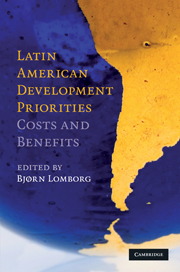Book contents
- Frontmatter
- Contents
- List of figures
- List of tables
- List of contributors
- Acknowledgments
- Abbreviations and acronyms
- Expert panel findings
- Introduction
- Democracy
- Education
- Employment and social security
- Environment
- Fiscal problems
- Health
- 6 Challenges and solutions in health in the LAC region
- 6.1 Challenges and solutions in health: an alternative view
- Infrastructure
- Poverty
- Public administration
- Violence and crime
- Conclusion
6 - Challenges and solutions in health in the LAC region
Published online by Cambridge University Press: 05 June 2012
- Frontmatter
- Contents
- List of figures
- List of tables
- List of contributors
- Acknowledgments
- Abbreviations and acronyms
- Expert panel findings
- Introduction
- Democracy
- Education
- Employment and social security
- Environment
- Fiscal problems
- Health
- 6 Challenges and solutions in health in the LAC region
- 6.1 Challenges and solutions in health: an alternative view
- Infrastructure
- Poverty
- Public administration
- Violence and crime
- Conclusion
Summary
Defining the challenges
The overall challenge can be expressed in one sentence: People do not always get the healthcare they need. Of course, to provide all the care that would ever do something to improve health, with no concern for cost, could use far more of society's resources than would make any sense. Spending too much on healthcare might actually worsen health outcomes, as resources were withdrawn from education, food, environmental protection, or other inputs to health. So the challenge or problem can be re-phrased as: Of the interventions that society decides it can afford, people do not always get all those that they need. “Intervention” is used in the sense of Disease Control Priorities in Developing Countries, 2nd edn. (Jamison et al. 2006, hereafter DCP2, chapter 15): actions are not limited to individual medical care but include public health measures. “Care” in this sense includes even the provision of information about health risks. If some people receive needed interventions more readily than others, the challenge is one of disparities.
One way to decompose the challenge ascribes the problem to four causes:
People don't realize that they need care (that is, demand is lacking)
They lack access to care, for financial, physical, and cultural reasons (health facilities are too costly to the patient, too distant, or impose cultural barriers to their use, such as language differences – these are supply deficiencies)
When care is accessible, it is provided inefficiently (priorities are set badly or left to chance, resources are wasted through imbalances among inputs or operation at uneconomical scale, and so on) and
[…]
- Type
- Chapter
- Information
- Latin American Development PrioritiesCosts and Benefits, pp. 293 - 341Publisher: Cambridge University PressPrint publication year: 2010

